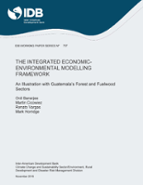The Integrated Economic-Environmental Modelling Framework: An Illustration with Guatemala's Forest and Fuelwood Sectors
Date
Nov 2016
This paper develops and operationalizes the Integrated Economic-Environmental Modelling (IEEM) platform which integrates environmental data organized under the first international standard for environmental-economic accounting with a powerful economy-wide modelling approach. IEEM enables the ex-ante economic analysis of public policies and investment on the economy and the environment in a quantitative, comprehensive and consistent framework. IEEM elucidates the two-way interrelationships between the economy and environment, considering how economic activities depend on the environment as a source of inputs and as a sink for its outputs. In addition to standard economic impact indicators such as gross domestic product, income and employment, IEEM generates indicators that describe policy impacts on the use of environmental resources, wealth and environmental quality which together determine prospects for future economic growth and well-being. To illustrate the analytical capacity of IEEM, the model is calibrated with Guatemala's environmental-economic accounts and applied to analysis of its forest and fuelwood sector where negative health and environmental impacts arise from inefficient household fuelwood use.




